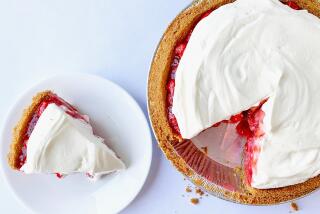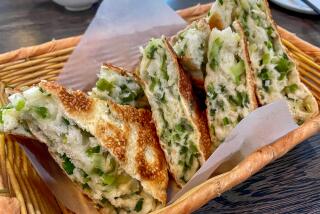Apple Pie--or Just Another Pretty Face?
The instructor brought out the ingredients for her apple pie: ready-made pie crust, T-pins, instant mashed potatoes (flake style is best, she said), Fun Tak glue and sandpaper. Oh, yeah, and some apples.
It was a workshop at Food on Film, an annual conference for food stylists now in its eighth year. Maybe you thought the surgical enhancement school of food styling had been laughed to death in the ‘80s, but uh-uh, no way.
The leader of the workshop (“Advanced Pies--Topping It Off”) explained that the mashed potatoes were needed to support a gorgeously high pie crust. You wouldn’t use apples, God forbid; they shrink in baking.
“Speaking of crusts,” she added, “Flako is my favorite brand.” Hmm. They don’t tell you about Flako at the Culinary Institute of America. I made a note to check out this Flako stuff later.
“And you mustn’t forget your T-pins when preparing your pie,” she said urgently. “They will come in handy for those unruly apple slices that just refuse to stay in place.”
The apple slices were cooked separately in real pies or by themselves and then sorted for looks. She referred to the most glamorous ones--the ones that were going into the mashed potato pie--as the “hero” slices.
Applying the apples to an apple pie for the camera is an exacting business. You remove a slice from the pie and then excavate mashed potatoes from under the crust (she actually used a scalpel) to make some room, then insert the apple slices--but not too neatly, she emphasized. You want that casual, adorably haphazard, homemade look.
Displaying a slice on a spatula, she emphasized, was one of the best ways to give camera the “true feeling” of the pie. But handling that carefully constructed slice could be difficult, because it’s a house of cards--or rather, a house of mashed potatoes, apple slices and pins.
The trick, she explained, is to cut a wedge-shaped piece of sandpaper and stick it onto the spatula using Fun Tak. Then all you have to do is place the piece of pie on the sandpaper. Voila! No slipping.
The final touch, she said, was to put some drips and drools of apple pie juice on the plate. Getting them to look natural and spontaneous but not just plain sloppy is evidently a craft as demanding as Japanese flower arrangement.
Why would anyone of sound mind fly from L.A. to Minneapolis to learn about hero apple slices? Ignorance. I thought food styling meant presenting food attractively. If I’d known it meant baking mashed potato pies, I would have thought two or three times about it.
But I persevered. The next workshop I’d signed up for was titled “Fish and Seafood--Even in Difficult Situations.” The leader gave her list of crucial food-styling equipment. At the top was the paint stripper, a device used for blistering the paint off wood. She called it “an oven on a stick.”
This paint stripper--or oven on a stick, whichever you prefer--could be plugged into any outlet on location and used to give fish a cooked appearance for photos. “They’re available at finer painting supply and hardware stores in your area,” she informed us. If only they sold them at kitchenware stores.
Among the other crucial items were Future Glue for holding uncooperative fish together, floral wire for pretty much the same purpose but especially useful on shrimp, and finally the wooden clothespin, whose purpose I never did quite get.
The rest of the two-day conference continued in the same vein. I attended workshops titled “Styling ‘Real’ Dairy Products” (as opposed to fake ones, I determined), “Turning an Ugly Duckling into a Swan” (how to make unappetizing-looking food look good, of course) and “A Word From the Herd--Styling Beef for Photography.”
At the end of the two days I was left with mixed feelings. On one hand, I was proud that at The Times, we do not practice these deceptive tactics. In our weekly food section, we photograph the actual recipes we give.
On the other, I felt a little disillusioned. Instead of being shocked and dismayed, as I was, the hundreds of food stylists in attendance were genuinely grateful for all the new techniques of deception they had learned.
My lesson for you aspiring cooks: Take heart. When your apple pie doesn’t come out 5 inches high or your fish gets a little flaky, don’t despair. Like those carefully styled shots of supermodels who leave the rest of us wanting to hide under our beds and never come out, food photos are not always what they appear to be.


